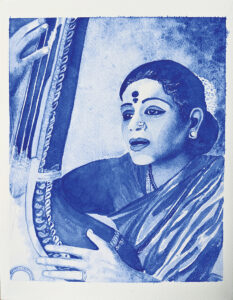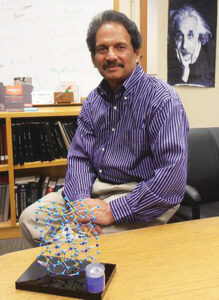Registered with the Registrar of Newspapers for India under R.N.I 53640/91
Vol. XXXI No. 15, November 16-30, 2021
The Bluest Blue
by V. Vijaysree
MS Blue is the distinctive shade of blue, named for the legendary singer M.S. Subbulakshmi. Now, YInMn blue, (pronounced yin-min) or “Mas Blue,” is all set to wow the world of art. “Mas” comes from the initials of Prof. M.A. Subramanian, the material scientist from Madras, the inventor of the vivid blue pigment.
Modern computers can display a slew of colors and creative humans could always dream up unique hues, but to transform any color, digital or imagined, into something real – say something you can paint a wall with or dye a piece of silk fabric with – you need a pigment, and its creation calls for considerable ingenuity. In a nutshell, that is why the invention of the pigment YInMn blue is a big deal.

Portrait of M.S. Subbulakshmi in Mas/YInMn Blue by Anu Nagarajan, a New York-based biophysicist.
“People have been looking for a good, durable blue pigment for a couple of centuries now,” says the academic, who earned his PhD from IIT, Madras. He wrote the first chapter of his doctoral thesis sitting on the grounds of Ashtalakshmi Temple in Besant Nagar, close to campus. “Nearly all my formal education was from places within a few mile-radius of my home in Mambalam,” says the scientist who moved to Texas for his post-doctoral research.
After a distinguished career for over two decades at DuPont, the chemical giant, where he discovered several functional materials that found use in electronics, he now teaches chemistry in Oregon State University.
In 2009, a graduate student in Subramanian’s research team at the university, pulverized a mixture of the oxides of yttrium, indium, and manganese, and baked the mixture, to try and create another material with novel electronic properties. When they opened the oven door the next day, a dazzling blue powder greeted them. His first thought Subramanian says, was “perhaps, the student has made some mistake.” But then, he recalled colleagues at DuPont saying that blue pigments are hard to make. What was really going on?
So, they repeated the experiment and tested the material. It was non-toxic and stable. Besides, it was resistant to heat and impervious to water, oil, and acids. Further, the material didn’t fade in sunlight and could block solar heat efficiently. So, it was an excellent candidate for use in outdoor paints and industrial coatings. It was not going to be an inexpensive pigment, given its ingredients.
The aesthetics of YInMn blue sets it apart from other pigments. The reason YInMn blue is special is because, this blue is very similar to the ultramarine blue used by Michelangelo in the Sistine Chapel, says Subramanian. His ‘Last Judgement’ used this very bright and beautiful blue. During the Middle Ages, the pigment was made from lapis lazuli mined from caves in the Hindu Kush mountains.

Mas Subramanian.
Before the invention of YInMn blue, Subramanian did not like visiting art museums. He says he used to grumble when he had to accompany his wife, Rajeevi, an amateur artist and material scientist, to Louvre (France), Prada (Spain) and Guggenheim (U.S.A) to look at the work of the Old Masters. Now those paintings, especially the ones that feature blue pigments, speak to him. Over the last decade, Subramanian has been an invited speaker at top art museums.
Synthetic blue pigments have a rich history. The early 18th century saw the discovery of the first modern synthetic blue pigment, Prussian, or Berlin blue. In the next century, Cobalt blue made its appearance. Synthetic ultramarine came soon after – we still use a form of ultramarine to make our white clothes appear whiter – but its manufacture is not green, in that it pollutes the environment.
Still these pigments, which could be manufactured in bulk, were just shades of blue, before the old masters painted with them. Hokusai’s famous “Great Wave off Kanagawa,” a familiar screensaver on the Apple Macintosh, uses Prussian blue, to great effect. Van Gogh’s “Starry Night” makes stunning use of Cobalt blue. In “Starry Night Over the Rhone,” the Dutch Master used all three pigments—Prussian blue, Cobalt blue, and synthetic ultramarine—to capture nighttime hues of the European river.
Earlier in 2021, YInMn blue became widely available to artists. Soon, someone could paint a modern masterpiece worthy of the pigment. Meanwhile, the Vatican has reportedly considered using YInMn blue in the restoration work at Sistine Chapel.
For color scientists, YInMn blue is a gift that keeps on giving (something of an Akshayapatra, if you will.) Subramanian’s research team has used its understanding of its crystal structure and chemical makeup to try and create other safe, stable synthetic pigments of various hues.
How so? By modifying the amount of indium and manganese in YInMn, the researchers could tweak the intensity of blue from light blue to almost black. Next, they tweaked the elements in the material. By adding copper, they got a green pigment; with the addition of iron, they got an orange pigment. Their holy grail is a bright, stable red, the kind which a luxury automobile maker like Ferrari can use to paint sport cars. People in the industry say that the inventor of the Ferrari red can hope to retire early.
The researcher, who earned his PhD in 1982, still enjoys spending time in the lab. “People say you don’t have a life if you do this, but it’s not true. It’s simply that you enjoy what you do,” says the man whose name is now part of pigment lore thanks to the creation of YInMn blue. Despite his new fame, and new interest in art, he remains a man of simple tastes, who loves his work, and his curd rice and pickle.
In the university in Corvallis, where Subramanian teaches, the pigment he created is popularly known as Mas blue. “Mas,” in Spanish, means more. YInMn blue is bluer, and for very specific reasons, better compared to any blue pigment humankind has seen before.

